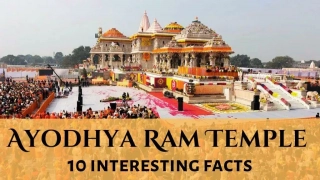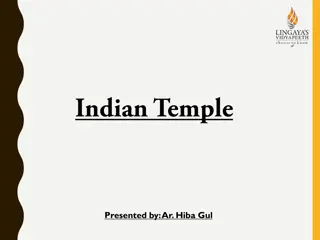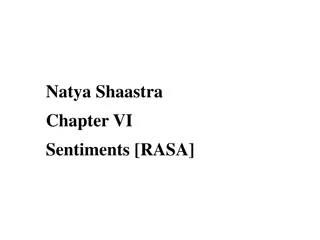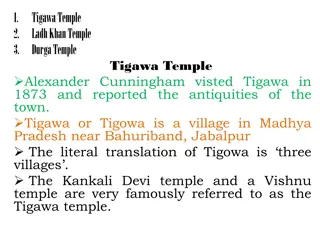Exploring Ancient Indian Temple Architecture
Ancient Indian temples are renowned for their intricate decorations, architectural elements, and unique features like the garbha-griha. The design principles reflect the aims of human life according to Indian philosophy, promoting self-realization and contemplation. Hindu temple sites are often located near natural water bodies, while layouts follow the geometrical design of vastu-purusha-mandala. The Silapasastras categorize temple architecture into Nagara, Dravida, and Vesara styles, each associated with specific regions and characteristics.
Download Presentation

Please find below an Image/Link to download the presentation.
The content on the website is provided AS IS for your information and personal use only. It may not be sold, licensed, or shared on other websites without obtaining consent from the author. Download presentation by click this link. If you encounter any issues during the download, it is possible that the publisher has removed the file from their server.
E N D
Presentation Transcript
One important part of the ancient Indian temples was their decoration. It is reflected in the multitude details of figured sculpture as well as in the architectural elements. Another important component of Indian temples was the garbha-griha or the womb chamber, housing the deity of the temple. The garbha-griha was circumambulation passage around. In the initial stages of its evolution, the temples of North and South India were distinguished on the basis of some specific features like sikhara and gateways. In the north Indian temples, the sikhara remained the most prominent component while the gateway was generally unassuming. provided with a
Design The four essential and significant principles which are also aims of human life according to Indian philosophy are the quests for (i) artha - wealth and prosperity; (ii) kama - sex and pleasure; (iii) dharma - moral life and virtues; (iv) moksha - self knowledge and realisation The encouragement and further purification of mind and prompt the process of self-realisation in devotees Hindu temples suggest contemplations,
Site The areas of Hindu temple sites are usually vast with many of them built near water bodies, in the lap of nature Leading Hindu temples are suggested near natural water bodies like confluence of rivers, river banks, seashores and lakes Layout Layout of a Hindu temple pursues a geometrical design known as vastu-purusha-mandala The name of which is derived from the three vital components of the design namely Vastu meaning Vaas or a place of dwelling; Purusha, meaning the Universal principle; and Mandala meaning circle
Silapasastras refer to three major styles of temple architecture, Nagara, Dravida, and Vesara Nagara style is associated with the land between the Himalayas and Vindhyas. Dravida style with the land between the Krishna and Kaveri rivers Vesara style is sometimes associated with the area between the Vindhyas and the Krishna river.
NAGARA STYLE : The Nagara style has its origin in the structural temples of the Gupta period, especially the Dashavtara temple of Deogarh The plan is square with a number of gradual projections in the middle of each side which Imparts it a cruciform shape. In Nagara style temples, the structure consists of two buildings, the main shrine taller and an adjoining shorter mandapa. The main difference between these two is the shape of the shikhara.
In the main shrine, abell shaped structure further adds to the height. In this style, the temples mainly are formed of four chambers, first the second Jagmohan , third Natyamandir and fourth chamber the Bhogamandir . That the prototype of the North Indian temple already existed in the 6th century can be seen in surviving temples such as the temple at Deoghar, Bihar state, which has a small, stunted sanctuary. Deoghar, also spelled Deogarh, city, northeastern Jharkhandstate, northeastern India. It is situated on the Ajay River in the Rajmahal Hills. Garbhagriha , then shikhara over the
Vishnu temple, Deoghar, Jharkhand, India. Frederick M. Asher
In the northern Nagara style, the shikhara takes the shape of a curvilinear beehive. The temple is a square with a number of graduated projections in the middle of each side, giving a cruciform shape with a number of re-entrant angles on each side. The projections in the plan are also carried upwards to the top of the shikhara, giving a strong emphasis on vertical lines in elevation . Lingaraj Temple, Bhubaneshwar, Orissa: The 11th century Lingaraj Temple is a fine example of the north Indian Nagara style of temple architecture, marked by its curvilinear, beehive-shaped shikhara.
Dravidian temple architecture evolved in South India predominantly comprise of temples built of sandstone, soapstone or granite. The square-shaped temple called Vimana has one or more storied pyramidal roof while its cell houses the image or emblem of the God. The Mandapas/Mandapams or porches are built in such a way that these precede and cover the door that leads to the cell. The Gopurams/Gopuras or elaborate gateway-towers or gate-pyramids encloses the temples. The Chaultris or pillared halls employed for different purposes forms one of the principal and constant features of this style. Temple tanks, wells, abodes of priests and other important buildings form part of this temple style. The famous Thanjavur temple of Tamil Nadu typifies this style.
VESARA STYLE : It emerged during early medieval period. It is a hybrid style that borrowed from the northern and southern styles. So, it is a mixture of both Nagara and Dravida styles of temple architecture. Temples built in the Deccan under the later Chalukyas of Kalyani and Hoysalas are considered examples of this style. Vesara style reduces the height of the temple towers even though the numbers of tiers are retained. This is accomplished by reducing the height of individual tiers. The semi circular structures of the Buddhist chaityas are also borrowed in this style, as in the Durga temple of Aihole. Many temples in Central India and Deccan have used the Vesara style with regional modifications. The Papanatha temple (680 AD) in particular and someother temples to a lesser extent located at Pattadakal demonstrate panache for this stylistic overlap .
The trend of merging two styles was started by the Chalukyas of Badami (500-735 AD) who built temples in a style that was essentially a mixture of the Nagara and Dravida styles Further refined by the Rashtrakutas of Manyakheta (750-983 AD) in Ellora, Chalukyas of Kalyani (983-1195 AD) in Lakkundi, Dambal, Gadag etc. and epitomized by the Hoysalas (1000-1330 AD). Most of the temples built in Halebid, Belur and Somanathapura are classified under this style.























